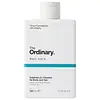What's inside
What's inside
 Key Ingredients
Key Ingredients

 Benefits
Benefits

 Concerns
Concerns

 Ingredients Side-by-side
Ingredients Side-by-side

Water
Skin ConditioningSodium Lauryl Sulfoacetate
CleansingDisodium Laureth Sulfosuccinate
CleansingSodium Lauroyl Sarcosinate
CleansingCocamidopropyl Hydroxysultaine
CleansingCocamidopropylamine Oxide
CleansingSodium Cocoyl Isethionate
CleansingPEG-150 Distearate
EmulsifyingDi-PPG-2 Myreth-10 Adipate
EmollientCocamide Mea
EmulsifyingGlycol Distearate
EmollientPolysorbate 20
EmulsifyingCaffeine
Skin ConditioningCinnamidopropyltrimonium Chloride
Glycerin
HumectantAmodimethicone
C11-15 Pareth-7
EmulsifyingLaureth-9
EmulsifyingTrideceth-12
EmulsifyingHydrolyzed Wheat Protein
Skin ConditioningCaprylyl Glycol
EmollientPhenoxyethanol
PreservativeWheat Amino Acids
Skin ConditioningHydrolyzed Soy Protein
HumectantDimethyl Sulfone
SolventPolyquaternium-10
Taurine
BufferingAspalathus Linearis Extract
Skin ConditioningParfum
MaskingBenzyl Benzoate
AntimicrobialBenzyl Cinnamate
PerfumingTetrasodium EDTA
Citronellol
PerfumingHexyl Cinnamal
PerfumingLinalool
PerfumingCI 15985
Cosmetic ColorantBiotin
AntiseborrhoeicCalcium Pantothenate
Alcohol Denat. Sd Alcohol 40
SolventTocopherol
AntioxidantAesculus Hippocastanum Seed Extract
Skin ConditioningRetinyl Palmitate
Skin ConditioningLinoleic Acid
CleansingPEG-35 Castor Oil
EmulsifyingInositol
HumectantCopper Tripeptide-1
Skin ConditioningCI 14700
Cosmetic ColorantPolyquaternium-11
Arginine
MaskingPEG-12 Dimethicone
Skin ConditioningPanax Ginseng Root Extract
EmollientAcetyl Tyrosine
Skin ConditioningArctium Majus Root Extract
Skin ConditioningEthylbisiminomethylguaiacol Manganese Chloride
AntioxidantNiacinamide
SmoothingOrnithine Hcl
Skin ConditioningZinc Gluconate
Skin ConditioningCitrulline
Skin ConditioningGlucosamine Hcl
Hydrolyzed Proanthocyanidin
AntioxidantCitric Acid
BufferingWater, Sodium Lauryl Sulfoacetate, Disodium Laureth Sulfosuccinate, Sodium Lauroyl Sarcosinate, Cocamidopropyl Hydroxysultaine, Cocamidopropylamine Oxide, Sodium Cocoyl Isethionate, PEG-150 Distearate, Di-PPG-2 Myreth-10 Adipate, Cocamide Mea, Glycol Distearate, Polysorbate 20, Caffeine, Cinnamidopropyltrimonium Chloride, Glycerin, Amodimethicone, C11-15 Pareth-7, Laureth-9, Trideceth-12, Hydrolyzed Wheat Protein, Caprylyl Glycol, Phenoxyethanol, Wheat Amino Acids, Hydrolyzed Soy Protein, Dimethyl Sulfone, Polyquaternium-10, Taurine, Aspalathus Linearis Extract, Parfum, Benzyl Benzoate, Benzyl Cinnamate, Tetrasodium EDTA, Citronellol, Hexyl Cinnamal, Linalool, CI 15985, Biotin, Calcium Pantothenate, Alcohol Denat. Sd Alcohol 40, Tocopherol, Aesculus Hippocastanum Seed Extract, Retinyl Palmitate, Linoleic Acid, PEG-35 Castor Oil, Inositol, Copper Tripeptide-1, CI 14700, Polyquaternium-11, Arginine, PEG-12 Dimethicone, Panax Ginseng Root Extract, Acetyl Tyrosine, Arctium Majus Root Extract, Ethylbisiminomethylguaiacol Manganese Chloride, Niacinamide, Ornithine Hcl, Zinc Gluconate, Citrulline, Glucosamine Hcl, Hydrolyzed Proanthocyanidin, Citric Acid
 Reviews
Reviews

Ingredients Explained
These ingredients are found in both products.
Ingredients higher up in an ingredient list are typically present in a larger amount.
Phenoxyethanol is a preservative that has germicide, antimicrobial, and aromatic properties. Studies show that phenoxyethanol can prevent microbial growth. By itself, it has a scent that is similar to that of a rose.
It's often used in formulations along with Caprylyl Glycol to preserve the shelf life of products.
Polysorbate 20 is made by combining ethoxylation of sorbitan, ethylene oxide, and lauric acid. It is a mild cleansing agent, surfactant, and emulsifier.
As a surfactant, it helps collect dirt and oils for washing. Emulsifiers prevent oils and water from separating.
Polysorbate 20 also adds scent to a product. Since it is made using sorbitol, it has a sweet scent. Sorbitol can also be found in fruits such as apples and peaches.
The lauric acid used to create Polysorbate 20 is often derived from coconuts.
Polysorbate 20 may not be fungal acne safe.
Learn more about Polysorbate 20Tocopherol (also known as Vitamin E) is a common antioxidant used to help protect the skin from free-radicals and strengthen the skin barrier. It's also fat soluble - this means our skin is great at absorbing it.
Vitamin E also helps keep your natural skin lipids healthy. Your lipid skin barrier naturally consists of lipids, ceramides, and fatty acids. Vitamin E offers extra protection for your skin’s lipid barrier, keeping your skin healthy and nourished.
Another benefit is a bit of UV protection. Vitamin E helps reduce the damage caused by UVB rays. (It should not replace your sunscreen). Combining it with Vitamin C can decrease sunburned cells and hyperpigmentation after UV exposure.
You might have noticed Vitamin E + C often paired together. This is because it is great at stabilizing Vitamin C. Using the two together helps increase the effectiveness of both ingredients.
There are often claims that Vitamin E can reduce/prevent scarring, but these claims haven't been confirmed by scientific research.
Learn more about TocopherolWater. It's the most common cosmetic ingredient of all. You'll usually see it at the top of ingredient lists, meaning that it makes up the largest part of the product.
So why is it so popular? Water most often acts as a solvent - this means that it helps dissolve other ingredients into the formulation.
You'll also recognize water as that liquid we all need to stay alive. If you see this, drink a glass of water. Stay hydrated!
Learn more about Water